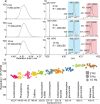Novel Hybrid Quadrupole-Multireflecting Time-of-Flight Mass Spectrometry System
- PMID: 36603847
- PMCID: PMC9896552
- DOI: 10.1021/jasms.2c00281
Novel Hybrid Quadrupole-Multireflecting Time-of-Flight Mass Spectrometry System
Abstract
A novel mass spectrometry system is described here comprising a quadrupole-multireflecting time-of-flight design. The new multireflecting time-of-flight analyzer has an effective path length of 48 m and employs planar, gridless ion mirrors providing fourth-order energy focusing resulting in resolving power over 200 000 fwhm and sub-ppm mass accuracy. We show how these attributes are maintained with relatively fast acquisition speeds, setting the system apart from other high resolution mass spectrometers. We have integrated this new system into both liquid chromatography-mass spectrometry and mass spectrometry imaging workflows to demonstrate how the instrument characteristics are of benefit to these applications.
Conflict of interest statement
The authors declare the following competing financial interest(s): All authors except A.V. and J.B.H. are employed by Waters Corporation who manufacture and sell mass spectrometers incorporating the technology described above. A.V. is the founder of MSC-CG Ltd. who helped develop the multireflecting time-of-flight technology presented above. StepWave, UPLC, ACQUITY, BEH, HDI, High Definition Mass Spectrometry, Masslynx, MassPREP, and UNIFI are trademarks of Waters Technologies Corporation. Encoded Frequent Pushing is a trademark of LECO Corporation.
Figures






References
-
- Wiley W. C.; McLaren I. H. Time-of-Flight Mass Spectrometer with Improved Resolution. Rev. Sci. Instrum. 1955, 26 (12), 1150–1157. 10.1063/1.1715212. - DOI
-
- Cotter R. J.Time-of-Flight Mass Spectrometry: Instrumentation and Applications in Biological Research; American Chemical Society, 1997.
-
- Willis P.; Jaloszynski J.; Artaev V. Improving Duty Cycle in the Folded Flight Path High-Resolution Time-of-Flight Mass Spectrometer. Int. J. Mass Spectrom. 2021, 459, 11646710.1016/j.ijms.2020.116467. - DOI
LinkOut - more resources
Full Text Sources

